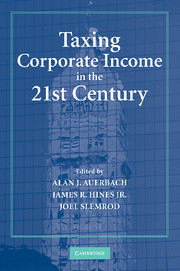Book contents
- Frontmatter
- Contents
- Contributors
- Preface
- 1 The Effects of Taxes on Market Responses to Dividend Announcements and Payments: What Can We Learn from the 2003 Dividend Tax Cut?
- Comments
- Comments
- 2 Dissecting Dividend Decisions: Some Clues about the Effects of Dividend Taxation from Recent UK Reforms
- Comments
- Comments
- 3 The 2003 Dividend Tax Cuts and the Value of the Firm: An Event Study
- Comments
- Comments
- 4 How Elastic Is the Corporate Income Tax Base?
- Comments
- Comments
- 5 An Empirical Examination of Corporate Tax Noncompliance
- Comments
- Comments
- 6 On the Extent, Growth, and Efficiency Consequences of State Business Tax Planning
- Comments
- Comments
- 7 Corporate Taxation and International Competition
- Comments
- Comments
- 8 The Changing Role of Auditors in Corporate Tax Planning
- Comments
- Comments
- 9 Taxation and the Evolution of Aggregate Corporate Ownership Concentration
- Comments
- Comments
- Index
- References
4 - How Elastic Is the Corporate Income Tax Base?
Published online by Cambridge University Press: 30 July 2009
- Frontmatter
- Contents
- Contributors
- Preface
- 1 The Effects of Taxes on Market Responses to Dividend Announcements and Payments: What Can We Learn from the 2003 Dividend Tax Cut?
- Comments
- Comments
- 2 Dissecting Dividend Decisions: Some Clues about the Effects of Dividend Taxation from Recent UK Reforms
- Comments
- Comments
- 3 The 2003 Dividend Tax Cuts and the Value of the Firm: An Event Study
- Comments
- Comments
- 4 How Elastic Is the Corporate Income Tax Base?
- Comments
- Comments
- 5 An Empirical Examination of Corporate Tax Noncompliance
- Comments
- Comments
- 6 On the Extent, Growth, and Efficiency Consequences of State Business Tax Planning
- Comments
- Comments
- 7 Corporate Taxation and International Competition
- Comments
- Comments
- 8 The Changing Role of Auditors in Corporate Tax Planning
- Comments
- Comments
- 9 Taxation and the Evolution of Aggregate Corporate Ownership Concentration
- Comments
- Comments
- Index
- References
Summary
The federal government of the United States primarily finances its expenditures from income taxation, at both the individual and corporate levels. Traditionally, corporate income taxation was about half as large as individual income taxation as a source of federal revenue; today, the ratio of corporate tax revenues to individual tax revenues is only about 15 percent. Nevertheless, a large economics literature continues to consider the corporate tax as a primary determinant of corporate behavior in the United States. Numerous articles have addressed the impact of the corporate tax on corporate investment and financing.
Oddly, this literature has not addressed directly the question of how sensitive the base of corporate income taxation is to the corporate tax rate. Past literature has addressed pieces of this question, but there is no clear estimate that emerges from past work. As emphasized by Saez (2004), what determines the ultimate efficiency of a tax system, absent external effects of taxation, is the elasticity of the base of taxable income with respect to the tax rate. Indeed, a large literature has arisen in public economics devoted to estimating this elasticity with respect to the individual income tax system. Yet there is no comparable work on corporate taxation.
In this chapter, we estimate the impact of the corporate tax rate on the level of corporate taxable income. An obvious difficulty with such an exercise is that the tax rate itself is determined by the level of taxable income.
- Type
- Chapter
- Information
- Taxing Corporate Income in the 21st Century , pp. 140 - 163Publisher: Cambridge University PressPrint publication year: 2007
References
- 35
- Cited by



